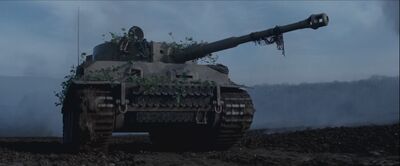
Tiger 131 is a German Tiger I Heavy tank captured by the British 48th Royal Tank Regiment in Tunisia during World War II. Preserved at The Tank Museum in Bovington, England, it is the only operating Tiger tank in the world.
This tank was used in the 2014 film Fury, the first time a real Tiger has appeared in a feature film since Theirs Is the Glory in 1946.
Description[]
Known to the Allies as a Tiger I, the German model designation was a Panzerkampfwagen VI, Tiger I (E), SdKfz 181. It was built in Kassel, Germany with the hull being constructed by Henschel while the turret was made by Wegmann A. The tank was completed in February 1943 with the chassis number 250112. It was shipped to Tunisia between 12 March and 16 April 1943. The tank was assigned to No. 3 Platoon in No. 1 Company of the 504th Schwere Heeres Panzer Abteilung (German heavy tank battalion) in Tunisia during the North African Campaign bearing the turret number 131 by which it has come to be known.
On 21 April 1943, the tank was knocked out and captured on a hill called Djebel Djaffa during the preliminary phases of the Battle of Longstop Hill which opened the way to the capture of Tunis. During the battle, Tiger 131 was hit by three shots from 6-pounders from British Churchill tanks of A Squadron, 4 Troop of the 48th Royal Tank Regiment. A solid shot hit the Tiger's gun barrel and ricocheted into its turret ring, jamming its traverse, wounding the driver and front gunner and destroying the radio. A second shot hit the turret lifting lug, disabling the gun's elevation device. A third shot hit the loader's hatch, deflecting fragments into the turret. The German crew bailed out, taking their wounded with them and leaving the knocked-out but still driveable and largely intact tank behind. Their identity and fate are unknown. The tank was secured by the British as they captured Djebel Djaffa hill. Tiger 131 was the first intact Tiger tank captured by British or American forces.
A 2012 book by Noel Botham and Bruce Montague stated that Major Douglas Lidderdale, the engineering officer who oversaw the return of Tiger 131 to England, was responsible for the capture of Tiger 131 as the leader of a secret mission appointed by Winston Churchill to obtain a Tiger for allied intelligence. The story has been told in brief in a 2012 article in the Daily Mail newspaper prior to the book's publication.
Though the account has been considered plausible (if only in light of Churchill's reputation for being 'hands on' in his dealings with military affairs during wartime) it has been rejected by the Bovington Tank Museum as inaccurate. The story as told in the book contradicts Lidderdale's own letters and papers written in the years before his death, in which he stated that he was not personally present when the Tiger was captured.
Tiger 131 was repaired with parts from other destroyed Tigers and inspected to judge its performance. It was displayed in Tunis and formally inspected there by King George VI and Winston Churchill. The tank was sent to England in October 1943 where it was displayed as a trophy at various locations to raise wartime morale before it was subjected to extensive testing and evaluation by the School of Tank Technology who produced detailed reports on its construction. The captured tank was transferred to the Bovington Tank Museum by the British Ministry of Supply on 25 September 1951 where it was given the accession number, 2351, (later E1951.23). In 1990, the tank was removed from display at the museum for restoration by the museum and the Army Base Repair Organisation. The restoration involved an almost complete disassembly of the tank. The Maybach HL230 engine from the museum's Tiger II was installed as the Tiger's original Maybach HL210 had been cut into cross sections for display. A modern fire-suppressant system was added to the engine compartment, the only other significant alteration. The wear and performance of the refitted Tiger engine was studied by metallurgists to explore the alloys and performance of WW II German manufacturing. In December 2003, Tiger 131 returned to the museum with a working engine, making it the only working Tiger tank in the world and the most popular exhibit at the museum. Further restoration and repainted period colours completed the restoration in 2012 totaling £80,000.
